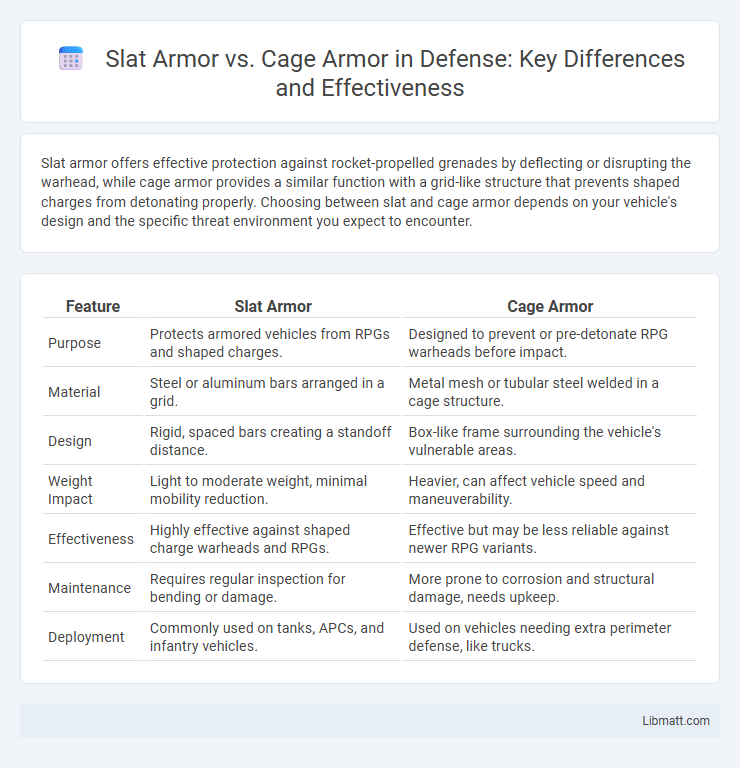Slat armor offers effective protection against rocket-propelled grenades by deflecting or disrupting the warhead, while cage armor provides a similar function with a grid-like structure that prevents shaped charges from detonating properly. Choosing between slat and cage armor depends on your vehicle's design and the specific threat environment you expect to encounter.
Table of Comparison
| Feature | Slat Armor | Cage Armor |
|---|---|---|
| Purpose | Protects armored vehicles from RPGs and shaped charges. | Designed to prevent or pre-detonate RPG warheads before impact. |
| Material | Steel or aluminum bars arranged in a grid. | Metal mesh or tubular steel welded in a cage structure. |
| Design | Rigid, spaced bars creating a standoff distance. | Box-like frame surrounding the vehicle's vulnerable areas. |
| Weight Impact | Light to moderate weight, minimal mobility reduction. | Heavier, can affect vehicle speed and maneuverability. |
| Effectiveness | Highly effective against shaped charge warheads and RPGs. | Effective but may be less reliable against newer RPG variants. |
| Maintenance | Requires regular inspection for bending or damage. | More prone to corrosion and structural damage, needs upkeep. |
| Deployment | Commonly used on tanks, APCs, and infantry vehicles. | Used on vehicles needing extra perimeter defense, like trucks. |
Introduction to Slat Armor and Cage Armor
Slat armor and cage armor are vehicle protection systems designed to defend against rocket-propelled grenades (RPGs) and other explosive projectiles. Slat armor consists of rigid metal bars spaced to disrupt the impact and detonate warheads prematurely, while cage armor features a grid-like structure mounted externally to intercept and neutralize incoming threats. Your choice between these two types depends on the specific vehicle, mission requirements, and threat level.
Historical Development of Vehicle Armors
Slat armor, also known as cage armor, was developed during the late 20th century to counter the threat of rocket-propelled grenades (RPGs) in asymmetric warfare. Its design consists of a metal grid that disrupts the shaped charge of RPG warheads before impacting the vehicle's main armor, representing an evolution from traditional composite and steel armors used in World War II and the Cold War. Modern military vehicles incorporate slat armor to enhance survivability without significantly increasing weight, reflecting advancements in adaptive protective technologies.
Design Features of Slat Armor
Slat armor features a grid-like framework of metal bars designed to disrupt and pre-detonate shaped charge warheads before they reach the vehicle's main armor. The spacing and thickness of the slats are optimized to deform or prematurely trigger rocket-propelled grenades, reducing penetration effectiveness. Its modular design allows quick replacement and upgrades while maintaining vehicle mobility and protection efficiency.
Key Characteristics of Cage Armor
Cage armor, also known as bar armor, features a lattice framework of metal bars designed to disrupt and prematurely detonate rocket-propelled grenades (RPGs) before impact, effectively protecting the vehicle's main armor. Its open-grid structure reduces weight compared to traditional solid plates and creates a stand-off distance that minimizes penetration damage. Cage armor is typically modular, allowing easy repair or replacement in combat conditions while maintaining vehicle mobility and operational flexibility.
How Slat Armor Works Against RPGs
Slat armor deflects RPG (rocket-propelled grenade) warheads by disrupting their shaped charge detonation, causing the grenade to either misfire or explode prematurely away from the vehicle's main armor. The spaced grid design ensures that the RPG's shaped charge cannot properly form its high-velocity jet, significantly reducing penetration effectiveness. If you rely on armored protection, slat armor provides an effective lightweight solution to mitigate RPG threats compared to heavier cage armor options.
Effectiveness of Cage Armor in Conflict Zones
Cage armor, also known as slat armor, offers proven effectiveness in conflict zones by protecting vehicles from RPGs and anti-tank missiles through deflection and detonation before impact. Its open-grid design reduces warhead penetration, significantly enhancing crew survivability during ambushes or roadside attacks. Your use of cage armor can greatly improve defense against common insurgent threats in urban and asymmetric warfare environments.
Comparative Analysis: Slat vs. Cage Armor
Slat armor offers superior protection against rocket-propelled grenades (RPGs) by causing early detonation and preventing warhead penetration through spaced metal bars, while cage armor provides a similar function but often with heavier, bulkier frames. The efficiency of slat armor is enhanced by its modular design, enabling easier repairs and replacements compared to the rigid structure of cage armor. Understanding these differences helps you choose the optimal armor configuration for vehicle survivability in combat environments.
Deployment on Modern Military Vehicles
Slat armor offers effective protection against rocket-propelled grenades (RPGs) by pre-detonating the warhead at a distance, making it ideal for rapid deployment on modern military vehicles such as MRAPs and armored personnel carriers. Cage armor, a variant of slat armor, features a grid-like framework that balances weight and coverage, enhancing mobility while maintaining defense against shaped-charge threats. Modern militaries prioritize these armor systems for their adaptability, ease of installation, and proven effectiveness in asymmetric warfare environments.
Advantages and Limitations of Each Armor Type
Slat armor offers effective protection against rocket-propelled grenades (RPGs) by causing premature detonation while being lightweight and easier to install on various vehicles, but it may be less effective against shaped charges and small arms fire. Cage armor provides a more robust defense against both RPGs and some forms of kinetic attack by physically intercepting projectiles, although it increases the vehicle's overall weight and can reduce maneuverability in tight spaces. Your choice between slat and cage armor depends on balancing the need for mobility with the level of protection required in operational environments.
Future Trends in Anti-RPG Protective Solutions
Future trends in anti-RPG protective solutions emphasize advanced composite materials that enhance slat armor's modularity and weight efficiency while improving cage armor's structural integrity and blast deflection capabilities. Integration of smart sensors and adaptive technologies promises real-time damage assessment and impact mitigation, significantly boosting battlefield survivability. Your choice in protective systems will benefit from innovations that balance lightweight design with superior resistance to shaped-charge threats.
slat armor vs cage armor Infographic

 libmatt.com
libmatt.com